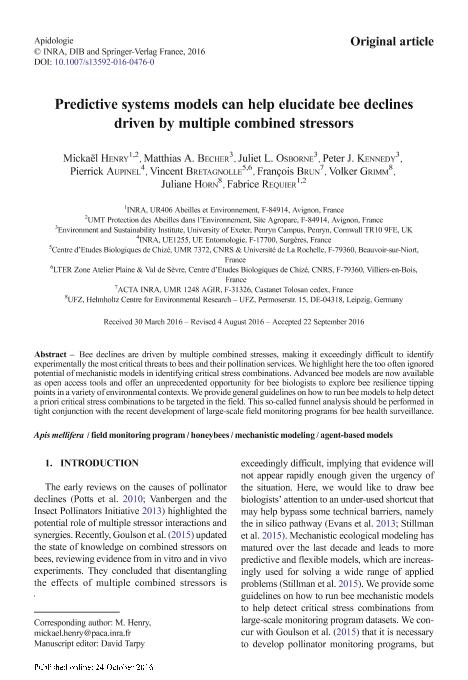Mostrar el registro sencillo del ítem
dc.contributor.author
Henry, Mickaël
dc.contributor.author
Becher, Matthias A.
dc.contributor.author
Osborne, Juliet L.
dc.contributor.author
Kennedy, Peter J.
dc.contributor.author
Aupinel, Pierrick
dc.contributor.author
Bretagnolle, Vincent
dc.contributor.author
Brun, François
dc.contributor.author
Grimm, Volker
dc.contributor.author
Horn, Juliane
dc.contributor.author
Requier, Fabrice

dc.date.available
2018-12-14T15:29:09Z
dc.date.issued
2017-05-24
dc.identifier.citation
Henry, Mickaël; Becher, Matthias A.; Osborne, Juliet L.; Kennedy, Peter J.; Aupinel, Pierrick; et al.; Predictive systems models can help elucidate bee declines driven by multiple combined stressors; EDP Sciences; Apidologie; 48; 3; 24-5-2017; 328-339
dc.identifier.issn
0044-8435
dc.identifier.uri
http://hdl.handle.net/11336/66489
dc.description.abstract
Bee declines are driven by multiple combined stresses, making it exceedingly difficult to identify experimentally the most critical threats to bees and their pollination services. We highlight here the too often ignored potential of mechanistic models in identifying critical stress combinations. Advanced bee models are now available as open access tools and offer an unprecedented opportunity for bee biologists to explore bee resilience tipping points in a variety of environmental contexts. We provide general guidelines on how to run bee models to help detect a priori critical stress combinations to be targeted in the field. This so-called funnel analysis should be performed in tight conjunction with the recent development of large-scale field monitoring programs for bee health surveillance.
dc.format
application/pdf
dc.language.iso
eng
dc.publisher
EDP Sciences

dc.rights
info:eu-repo/semantics/openAccess
dc.rights.uri
https://creativecommons.org/licenses/by-nc-sa/2.5/ar/
dc.subject
Agent-Based Models
dc.subject
Apis Mellifera
dc.subject
Field Monitoring Program
dc.subject
Honeybees
dc.subject
Mechanistic Modeling
dc.subject.classification
Otras Ciencias Biológicas

dc.subject.classification
Ciencias Biológicas

dc.subject.classification
CIENCIAS NATURALES Y EXACTAS

dc.title
Predictive systems models can help elucidate bee declines driven by multiple combined stressors
dc.type
info:eu-repo/semantics/article
dc.type
info:ar-repo/semantics/artículo
dc.type
info:eu-repo/semantics/publishedVersion
dc.date.updated
2018-11-22T14:53:56Z
dc.journal.volume
48
dc.journal.number
3
dc.journal.pagination
328-339
dc.journal.pais
Francia

dc.journal.ciudad
Paris
dc.description.fil
Fil: Henry, Mickaël. Institut National de la Recherche Agronomique; Francia. UMT Protection des Abeilles dans l’Environnement; Francia
dc.description.fil
Fil: Becher, Matthias A.. University of Exeter; Reino Unido
dc.description.fil
Fil: Osborne, Juliet L.. University of Exeter; Reino Unido
dc.description.fil
Fil: Kennedy, Peter J.. University of Exeter; Reino Unido
dc.description.fil
Fil: Aupinel, Pierrick. Institut National de la Recherche Agronomique; Francia
dc.description.fil
Fil: Bretagnolle, Vincent. Université de La Rochelle; Francia. Centre d’Etudes Biologiques de Chizé; Francia
dc.description.fil
Fil: Brun, François. Institut National de la Recherche Agronomique; Francia
dc.description.fil
Fil: Grimm, Volker. Helmholtz Centre for Environmental Research; Francia
dc.description.fil
Fil: Horn, Juliane. Helmholtz Centre for Environmental Research; Francia
dc.description.fil
Fil: Requier, Fabrice. Consejo Nacional de Investigaciones Científicas y Técnicas; Argentina. UMT Protection des Abeilles dans l’Environnement; Francia. Institut National de la Recherche Agronomique; Francia
dc.journal.title
Apidologie

dc.relation.alternativeid
info:eu-repo/semantics/altIdentifier/doi/https://dx.doi.org/10.1007/s13592-016-0476-0
dc.relation.alternativeid
info:eu-repo/semantics/altIdentifier/url/https://link.springer.com/article/10.1007/s13592-016-0476-0
Archivos asociados
